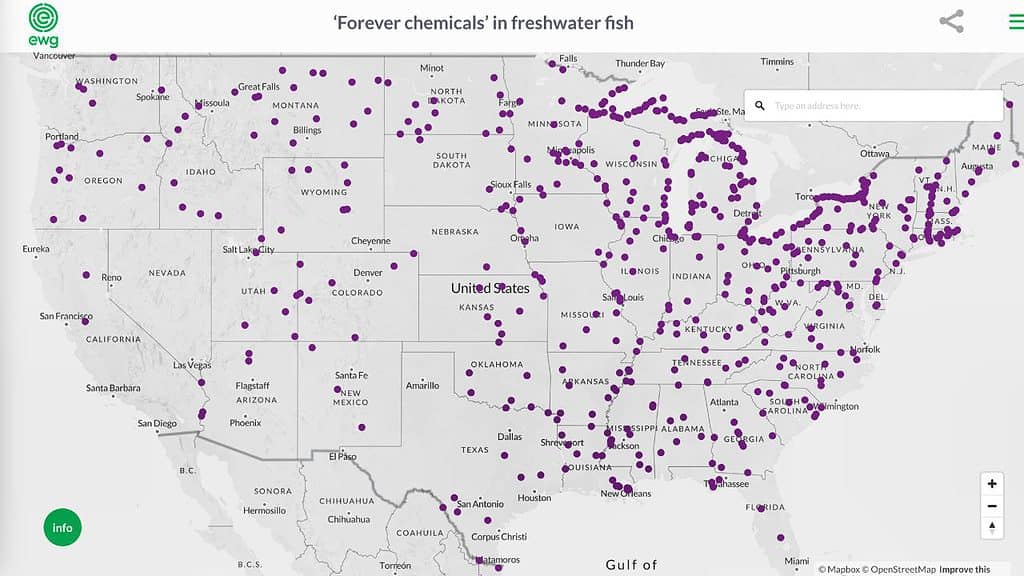A new study has found that fish caught in streams, rivers, and lakes in the United States have dangerously high levels of perfluorooctane sulfonic acid (PFOS), a synthetic toxic substance in the ‘forever chemicals’ class that has been phased out by the federal government. Eating one fish in a year equals ingesting water with PFOS at 48 parts per trillion, or ppt, for one month — a dangerous threshold.

The chemical PFOS is part of a family of manufactured additives known as perfluoroalkyl and polyfluoroalkyl substances (PFAS), widely used since the 1950s to make consumer products nonstick and resistant to stains and grease damage. They are often called “forever chemicals” as they don’t break down easily in the environment.
These chemicals can stay in the soil and water for long periods of time, and can accumulate in the bodies of animals and humans. They are concerning because some studies have suggested that exposure to high levels of PFAS may be linked to certain health problems, such as cancer, thyroid issues, and immune system disorders. Since these chemicals can migrate into the air, dust, food, soil, and water, researchers are understandably concerned.
“People who consume freshwater fish, especially those who catch and eat fish regularly, are at risk of alarming levels of PFAS in their bodies,” David Andrews, one of the study’s lead authors, said in a statement. “Growing up, I went fishing every week and ate those fish. But now when I see fish, all I think about is PFAS contamination.”
It’s more than just water
The researchers analyzed data from more than 500 samples of fish fillets collected in the US from 2013 to 2015 under monitoring programs by the EPA. The contamination was widespread across fish in the country. The median level of total PFAS was 9,500 nanograms per kilogram, reaching 11,800 nanograms per kilogram in the Great Lakes.
EWG found that the median amounts of PFAS in freshwater fish were an astounding 280 times greater than forever chemicals detected in some commercially caught and sold fish. The testing data, from the Environmental Protection Agency (EPA) and Food and Drug Administration (FDA), showed that consuming a single meal of freshwater fish could lead to similar PFAS exposure as ingesting store-bought fish every day for a year.
“This national fish testing by the Environmental Protection Agency has gotten little attention, which is quite surprising given the high levels of PFAS found in the freshwater fish. And, to our knowledge, there are very few publications analyzing these EPA data. And, to our knowledge, there are very few publications that have analyzed these EPA data,” Dr. Tasha Stoiber, a senior scientist at the Environmental Working Group and a coauthor of the new paper, told ZME Science.
“EWG’s study is unique in showing how even infrequent consumption of freshwater fish can have a significant impact on PFAS levels in the blood. Overall, the study points to the importance of diet as a source of PFAS exposure, and this is especially important for high frequency fish consumers,” the EWG researcher added.
Of all the forever chemicals, PFOS accounted for an average of 74% of the pollution in the fish, the researchers found. The remaining 25% was a mix of other PFAS also known to be damaging to human health. The researchers created an interactive map with the results for each state. Fish near urban areas were found to have three times more PFOS.

PFOS is known as a “long-chain” forever chemical, made up of an 8-carbon chain. Manufacturers voluntarily agreed back in the early 2000s to stop using long-chain PFAS in US consumer products. However, the industry reworked the chemicals, making them into 4- and 6-carbon chains. The new versions appear to have the same dangerous health effects as the old ones.
The widespread contamination of fish in rivers and streams across the country highlights the need to end industrial discharges of PFAS, the researchers said. In a previous study, they found there are over 40,000 industrial polluters of PFAS in the US – including manufacturing facilities, landfills, wastewater treatment plants, and airports.
“These findings support the urgency of reducing PFAS discharges and sources of pollution to surface water bodies. There is no practical method for treating surface waters for PFAS pollution so turning off the tap is what’s needed which includes reducing discharges and ending non-essential uses of PFAS. And the companies producing PFAS should be held accountable for the pollution,” Stoiber told ZME Science, adding that “the use of PFAS overall must be greatly reduced to lower the indirect impacts of PFAS to the environment from wastewater and urban runoff to watersheds.”
“What’s also needed is updated health protective guidance on the national level for fish consumption. “
The study was published in the journal Environmental Research.


